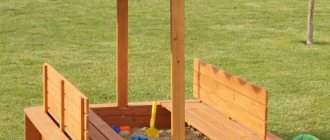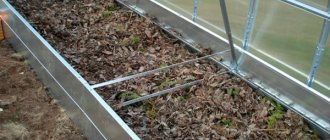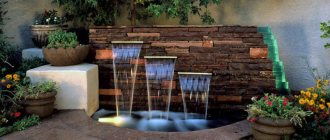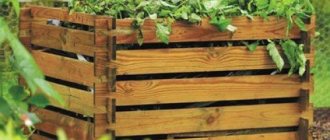One of the ways to decorate the territory of a farmstead in an original way is to create a decorative vegetable garden. This design technique allows you not only to improve the aesthetic appearance of the local area, but also to grow healthy vegetables and herbs. In such a garden, provided there is a favorable neighborhood next to vegetable crops, you can safely place flowers and fruit and berry plantings. The main thing is to decorate the garden beds in an unusual and beautiful way, so that both the owners will be happy and the guests will not be ashamed to show it.
Ideas for arranging beds
Modern summer cottages are rarely filled to capacity with beds. Usually they have space for a lawn, a swing, a playground, and a barbecue. But incorporating banal plantings of onions or tomatoes into the resulting decorative splendor may not be so easy.
In order not to turn your suburban paradise into a Soviet dacha, try to implement design solutions when growing vegetables.
Build vertical beds
Owners of small plots sometimes have a hard time when planning. After all, you want to place everything on your favorite acres at once, but there is almost no space left for planting. And if it is unrealistic to reduce the apple trees or barbecue, then, fortunately, with ridges this is quite feasible.
It is enough just to place your plantings not in a horizontal plane, as we are used to, but vertically.
Multi-tiered ridges, suspended wall structures, complex pyramids, and boxes on a fence are suitable for these purposes.
Plant a vegetable garden in containers
Are you actively planning your plot and don’t know what will be located where, but you want to harvest the crop this season?
Then for you – containers that roam around the territory, in which you can grow herbs and small amounts of vegetables. Containers can be either industrially produced or hand-made. The main thing is not to make them too deep so that the weight of the soil allows you to move the containers around the site.
Create a decorative vegetable garden (vegetables, herbs and flowers in one bed)
Do you always want to come to your garden with pleasure? Then plant vegetables and herbs mixed with flowers. The rich colors of marigolds, calendula, chamomile, hyssop or lavender will add decorative value to your plantings, and strong odors will repel pests.
Build raised beds from planed boards
If you have a traditional wooden house at your dacha, then high ridges made of planed boards will give the site uniformity and maintain the style.
On the outside, they can be either painted in bright colors or retain the natural shade of natural wood.
Don’t forget to impregnate the wood with special antifungal and protective biological agents - they will prolong the life of the structure and will not affect the planting in any way.
Make beds with decorative edges
Not only beds made of boards can be integrated into the design of the site. Wickerwork, brickwork, artificial stone, blocks, sheet iron and even slate can provide a worthy frame for plantings.
True, it is important to use the same type of material throughout the entire garden, maintain proportions and monitor the safety of the edges, repairing or changing elements if necessary.
Create neat beds in the middle of your lawn
Are you categorically against allocating areas for vegetable gardens?
Then you can make beds right in the middle of the lawn. Of course, they will look unusual, because flower beds usually play this role, but with due care in implementation everything will turn out great. Of course, rectangular shapes in this case can ruin everything, as can high sides.
But the dug-in border and long, winding ridges, in which one crop will be replaced by another, will become the highlight of your site.
Make beds of original shape (triangular, trapezoidal, round, etc.)
Do you want your garden to be unique and noticeable even on Google maps? Then create ridges of unusual shape with a clear outline. You can get by with geometric shapes, or you can create entire paintings.
However, remember that you will still have to take care of such beds, so do not make their elements too large so that later, in attempts to weed the center, you do not trample the edges.
Lay beautiful paths between the beds
Even the most ordinary beds can be made neat by laying permanent paths made of tiles, bricks, pebbles or wood between them. This way you will not only decorate the area, but also stop slipping in the mud after rain, and also dramatically reduce the weeding area. And it will be easier to track and destroy flightless pests on such paths.
Enclose your garden with a beautiful fence or hedge
For those who do not want to change anything in the garden, but are not ready to show off their potatoes and cucumbers to all the guests, the solution will be a small, neat fence separating one zone from another. A fence at the edge of the garden can have both aesthetic and practical functions, for example, to prevent your pets and small children from breaking through to the plantings.
It is not necessary to erect a two-meter solid structure; a wooden, wicker or carbonate fence 50-80 cm high will be sufficient.
Place a bench or deck chair next to the beds
For many summer residents, the sight of beds with a ripening harvest is even more pleasant than flowing water or a burning fire. But it’s better to admire them comfortably, without haste. To do this, equip yourself an observation post next to the garden - install a bench or deck chair.
You can also keep a notepad and pencil there to record all the ideas and plans that come to mind.
Install an arch or pergola with climbing plants at the entrance to the garden
It is possible to visually separate a vegetable garden area without a solid fence. It is enough to mark the entrance by installing a pergola or arch along which decorative or vegetable crops will weave.
The best decorations for such an arch would be maiden grapes, clematis, climbing beans, honeysuckle honeysuckle or hops.
Make the beds narrower and the passages between them wider
Only the lazy have not written about the advantages of narrow beds - they are convenient to process, plants receive more light and air, productivity increases, etc. But it is important not to forget about the wide passages between the ridges.
Overgrown with lawn grass or covered with sand, bark or pebbles, they look neat and turn even banal plantings into a decoration for the garden.
Arrange the beds in the form of a flower bed or alpine slide
Who said cabbage belongs in the garden? It (and other vegetables) may well become elements of flower beds, alpine slides, and mixborders. Moreover, there are vegetables that are truly created to fit perfectly into the flower garden.
These include colorful cherry tomatoes, bush beans with bright leaves, and leafy lettuces.
Build a spiral bed
A spiral bed always looks impressive and can also become the center of a decorative garden. It's not that difficult to create, although it does require some patience. In fact, this is an analogue of an alpine slide, but at the base it does not have stones and sand, but soil and plant debris.
You can lay out the contours of the spiral itself using either wild stone or bricks.
Plant flowers (marigolds, calendula, etc.) around the perimeter of the beds.
Flowers with a pungent odor planted around the perimeter will decorate and protect any garden bed from insect pests. They are unpretentious, and with the care that you provide to the vegetables, marigolds and calendula will feel at their best and will thank you with abundant flowering until frost.
Use arches as supports for climbing plants
Cucumbers, beans, pumpkin – what do these crops have in common? Of course, long lashes spreading throughout the garden and constantly crawling into other ridges and under your feet. Of course, you can tie up the stems, but you can’t have enough stakes for everything. But plastic or metal arches are inexpensive, last a long time, and cope with the task perfectly.
In addition, ripe vegetables are visible on them much better than on the ground, they do not get dirty and serve as a decoration for the garden.
Build a box bed with a beautiful trellis
A box bed is also well suited for planting climbing plants and storing plant and food residues. Most often, cucumbers are grown in these, but your imagination may not be limited by anything.
As in the case of high beds made of boards, all wood must first be soaked in antifungal agents and dried thoroughly.
Build a multi-tiered bed
Multi-tiered beds of complex shape are good as a design element, but are quite finicky in matters of care and maintenance. The material for them needs to be chosen of high quality and durable, but it is difficult to grow some large vegetables in such areas - there is not enough space.
It is best to build such a structure for herbs or an apothecary garden.
Make beds from gabions
If you have a lot of stones on your site, you are strong and have a lot of free time, you can build a structure made of gabions, which is often seen on city streets. Metal ones are again sold for them in construction and gardening hypermarkets, but the filling will have to be obtained independently.
Of course, such ridges are created to last for centuries, but this has not only advantages, but also disadvantages - moving the planting will not work so easily.
Use unusual objects as a base for your beds (an old boat, bed, wheelbarrow, chest of drawers, etc.)
Old items that have gone out of fashion or become unnecessary can be an excellent container for vegetables. Of course, getting a boat in an area without large bodies of water is not so easy, but everyone has old beds, broken cars or boxes.
Moreover, unnecessary things are often brought to the dacha, and you don’t have to store them in the shed, but give them a second life on the site.
Create beds on a slope
Have you unwittingly become the owner of a plot of land with a slope or ravine?
Don’t despair, terracing and geomats will allow you to turn this unsightly piece into a full-fledged vegetable garden. With the help of supports on the slope, you can hold back the soil, and bushes or ground covers planted in it will help stop the soil from sliding.
Build a gazebo next to your garden
Do you think that one bench near the garden is not enough for you, or do you want to admire the fruits of your labors with the whole family and in any weather?
Then place the gazebo next to the vegetable garden. You can relax in it, read topical magazines, and if you suddenly want to have a snack, you won’t have to go far - all the berries, vegetables and herbs are literally at your feet.
Decorative vegetable garden
You have probably noticed that vegetable and aromatic crops are beautiful both during flowering and during fruiting. Even potatoes bloom with cute flowers, and the rich color of their tops can be the envy of some flowers.
The multi-colored shiny peppers on the bush are beautiful, the red and green tomatoes, even the cucumber bed with plants climbing along the arch looks good.
There are also colorful salads, different types of cabbage, all sorts of parsley, dill and other healthy and fragrant herbs. Aesthetes noticed this and began to decorate the beds beautifully. There are even two different types of ornamental vegetable gardens.
French vegetable garden
In the classic version, these are symmetrical beds, in the center of which there is a sculptural group, a fountain, and another recreation area. Such vegetable gardens were made near castles, and they were also a place of rest. The strict geometry of the planned site further emphasized the splendor of the castle. He was always the priority.
Clearly shaped beds, their boundaries marked by border plantings
In the modern version, the beds can be square, rectangular, or in the form of a sector of a circle. All of them are separated by clear paths; border plants are planted along the edges of the beds. It’s clear that you can’t install a pure French vegetable garden on your 6-10 acres, but it’s very possible to do something similar.
In general, there are two types of beds - at the same level with the soil and raised.
It is easier to organize a vegetable garden on one level, but raised beds are more convenient to cultivate. To fence them, you can use boards, or slate cut into strips; if desired, the fence can be made of stone or woven from wicker. This is who can or wants to aim at what. For a few examples of how to make a fence for beautiful garden beds, see the photo.
You cut flexible branches from the forest (willow, for example) and while they are fresh, weave a fence for a raised bed
A fence made of boards is quick and easy, you just need to saturate the boards with a bioprotective compound, otherwise they will turn black and be unattractive
For beds at the same level with the ground, plants can be used instead of borders. For example, parsley, regular or curly, lettuce of different colors. It is clear that the plants will be gradually cut off, but you can first plant them densely, gradually thinning out the planting.
If space allows, along the edge of the beds you can plant marigolds or calendula, only a low border, other plants that produce dense greenery and grow small in height.
The main focus of the French vegetable garden is the layout and evenly planted rows. The second is in the alternation of colors. The third is in beautifully made paths that highlight the greenery.
To make everything look beautiful, you need to alternate the shades of plants, and to imagine how everything will look, it is better to draw in color.
They draw as best they can: on a computer in a design program or on a landscape sheet. There you can also develop a layout of the beds yourself if you draw everything to scale. Then the ideas will need to be transferred to the site. There are several options for bed layouts in the photo.
Basic recommendations for planning a vegetable garden
Modern landscape design concerns not only the arrangement of a recreation area and a garden on a site. Landscape architects have developed a number of recommendations, thanks to which any gardener can plan and arrange a garden design with their own hands.
- Zoning of the site . When thinking about the arrangement of a site where buildings have not yet been built, at the design stage it is necessary to provide for the placement of all the necessary zones: front, recreation, utility.
- Lighting and surface of the garden area . The area for vegetable beds should be illuminated from all sides. Vegetable crops are mostly sun-loving and demanding on soil. By placing the beds in a sunny area with fertile soil, you make it easier for yourself to comply with special conditions for planting and crop rotation.
- Limited planting area . If you do not set yourself the goal of providing all your relatives and friends with stocks of jams and pickles from your own harvest, it is better to limit the planting area. Three or four neatly cultivated beds will look more attractive and bring more benefits than a dozen unkempt ones.
- Unusual shape and arrangement of beds . When laying out vegetable beds, it is important to take into account both the aesthetic appearance of the plant compositions planted in them, and the needs of the plants themselves. Intricate ornaments and patterns created from slightly raised beds in the shape of trapezoids, triangles and waves are not always suitable for growing moisture-loving crops. Water in such beds dries out faster, which leads to uneven plant growth.
- The ratio of the width of the beds and the passages between them . Traditionally, many of us create beds 1-1.2 m wide. Foreign gardeners are of the opinion that the width of the bed should not exceed 70 cm. And this makes sense: it is easier to care for such a bed, maintaining an attractive appearance of the planting and increasing thereby the harvest.
Material on how to plant a small area with edible crops will also be useful:
Landscaping work can be aimed at arranging a decorative vegetable garden, which is also an important component of garden aesthetics
An example of a French vegetable garden. The width of the passage between low beds should be at least 40 cm, and between high beds - 70 centimeters
Where to begin
First of all, you need to draw up a plan for your garden. To do this, it is worth answering the following questions.
- Will the vegetable garden occupy the entire area of the plot, or will there be a flower garden, fruit trees, lawn, swimming pool or something else next to it?
- What crops will you grow, what conditions do they need?
- How they fit together: Keep in mind that some plants do not grow well next to each other or may infest each other with pests.
- How will you design the beds, what materials will you use?
- What materials are needed for walkways?
The plan can be drawn up on paper or using a computer. The method is not so important, it is important that in the end you have a detailed landscape design scheme for your plot with a vegetable garden. The plan diagram may look something like the figure. Below, write what each number corresponds to.
You need to mark everything on the plan: the size of the beds, the width of the paths, materials, decorative elements, types of plants. If you are drawing up a plan on a computer, attach a photo to get an idea of what your garden should look like.
It is important to think about which crops will bloom and bear fruit in different seasons, as well as their interchangeability, because as they are used for food, plants may lose their decorative appearance or simply run out.
It is also necessary to provide convenient paths to all areas of the garden. It is better if they are paved with hard material. Make an estimate for setting up your garden. Consider not only the price of plants and materials, but also the cost of delivery and labor.
To work out the technology for setting up an ornamental vegetable garden, I used my own plot.
The decision was made several years ago, when during a 2-year course on landscape architecture at the Nature Conservation Society, the teacher showed us, among others, a slide of a French vegetable garden. I really wanted to do something similar on my site.
My “decorative French vegetable garden” is integrated into the garden as a separate green room.
Its walls are hedges of weeping white willow and brilliant cotoneaster, mixborder, and on the fourth side there are purple bird cherry, common mackerel and vines (maiden grape, yellow-leaved hop, petiole hydrangea).
- mixborder
- module with conifers
- Mackerel
- petiolate hydrangea
- purple bird cherry
- girl's grapes, hops
- garden in containers
- cotoneaster hedge
- mock orange
- willow hedge
- miniature rose lined with alyssum
- bed
- padding from flyers
- backfill made of decorative stone wool
- drainage
How to make a decorative vegetable garden with your own hands
Every gardener can build a modern and attractive garden corner on his own plot. Once you have decided on the style and chosen a place to plant the plants, you can move on to the next stages of work.
Necessary materials
To make a garden bed, you need to stock up on building materials in advance, selected in accordance with the style of the garden you have planned:
- long wooden blocks or boards;
- bricks;
- large-sized uncut stones;
- wooden round timber;
- picket fence made of wood, plastic or metal;
- fences woven from wicker or rattan;
- metal or plastic boxes, containers;
- curbstone.
The dimensions of the beds are chosen taking into account the area of the entire territory of the site and the size of the plants that will be planted there.
Photo: options for using materials for building beds
The beds are made of wooden boards and framed with a picket fence.
Bricks can serve as borders for a vegetable garden
The vegetable garden can be planted in flowerpots or wooden boxes
Sawn round timber forms a bed
Decorative flower beds can be decorated in any way you like, but in pursuit of beauty, do not forget about the practicality and durability of materials.
Choosing the location of the beds
The most common options for placing ornamental garden beds are:
- Flowerbed garden - small flowerbeds are formed in which flowering plants and vegetables, berries or herbs are planted next to each other. This approach is considered appropriate, since the yield of vegetable and fruit crops increases with the correct proximity.
- Modular placement - if there is free space, beds of various geometric shapes are made in which plants are planted. The beds are arranged in a strictly symmetrical order and can be alternated at certain equal intervals.
- Vertical method - containers or racks for planting plants are placed vertically on a brick wall or other strong support. This style significantly saves space and helps divide the area into zones.
- Container method - plants are planted in large portable containers in the form of plastic containers, clay flowerpots, wooden boxes. At any time, the location of the garden can be changed at your discretion by moving containers or changing their places.
In some cases, combining options for placing beds is acceptable, but there is no need to use all methods at once, as this will create a feeling of chaos.
Photo: beautiful and neat placement of beds
Modules for the vegetable garden can be made of wooden beams
Flowers and herbs grow in one flowerbed
Wooden containers act as flower beds
Vertical placement of the vegetable garden saves space
Original and compact flower beds make it possible to highlight the beauty of your site and create the impression of neatness and well-groomedness.
Selection and treatment of soil for decorative beds
To obtain a good harvest, garden crops require soil of varying composition and density. But there are also basic requirements for the quality of the substrate, which are common for the successful growth of all plantings:
- good breathability and looseness;
- the ability to transmit moisture and retain a small part of it;
- most plants require soil with a neutral pH;
- the presence of nutritious, easily digestible components.
Fertile soil consists of 25–30% black soil, 15–20% sand and 45–50% peat. The sand content allows you to saturate the soil with moisture and oxygen, and peat creates the necessary looseness and nutrient medium.
Fertile black soil is an ideal option for growing garden crops
If the soil on a site is far from ideal, it is enriched with fertilizers. For active growth and development of the above-ground parts of plants, nitrogen is needed, and the root system requires phosphorus components. To keep plants strong and disease-free, potassium is added. When adding organic fertilizers to the soil in the form of manure or humus, maintain a proportion of 70–100 kg per 100 sq. m plot. Mineral fertilizing is applied at the rate of 4.5–5 kg per 100 sq. m. m of garden area.
Stages of work using the example of brick beds
The simplest shape of a brick bed is rectangular. This design and the material itself are well suited for most architectural styles in which the house or outbuildings are made.
a brick bed is a convenient and original garden design
The work steps can be performed according to the following instructions:
- Choose a place for the bed and mark its shape using pegs and rope.
- Dig a pit 30–35 cm deep for the foundation.
- Sand is placed at the bottom of the pit, the layer thickness is 10 cm. The sand is evenly leveled and compacted.
- Formwork 20 cm wide is made from wooden boards for pouring the foundation. The height of the formwork above ground level must be at least 10 cm.
- The perimeter of the strip foundation is reinforced with steel wire or mesh; it is laid on a layer of broken bricks placed inside the perimeter between the walls of the formwork.
- The foundation cavity is filled with cement, which can be mixed with crushed stone for strength.
- After 48 hours, the formwork is removed, but the foundation must strengthen, and this will take 10–14 days.
- They begin laying out the bricks from the corners of the structure - the top brick needs to be laid on the bottom, and so as to cover half of the bottom brick - this is how a bunch is formed.
- On the laid bricks, fill the seams with cement using a spatula, promptly removing excess material so that the structure is smooth and neat.
- Wait 10–14 days until the masonry is completely strengthened and begin filling the flowerbed with soil substrate.
If you complete all stages of work in the correct order and wait the necessary time for the cement mixture to harden, the structure will last for many years.
Video: how to make a flowerbed from concrete and brick
Gardeners note that brick raised beds warm up faster in the spring, retain moisture in the summer and help cope with stagnant water if the site is located in a swampy area.
Methods of organizing and styles of decorative gardening
Basic organization techniques
Reception No. 1 Vegetables + flowers
This technique is characterized by a certain stepwise planting of plants. In this case, they are planted in groups of several species. The main feature of this technique is the combination of colors (greens + bright accents on flowering vegetables or ordinary flowers).
The bottom layer should always remain green (you can even use mosses), this will provide a beautiful cushion (if using conifers, save the colors for the winter).
Technique No. 2 Vegetable garden with “walls”
When we create our own piece, we expect it to look great all year long. Only, unfortunately, this is not the case.
In winter and autumn, the garden loses its beautiful appearance; to prevent this from happening, the designers came up with a special technique.
Its essence is that the vegetable garden is created on an elevation, and this elevation is fenced with stonework of different shades (for this you can use colored glass bottles or wooden materials).
Technique No. 3 Portable decorative vegetable garden
The main advantage of this type of garden design is mobility. It is very simple in design. Photos of containers can be found on any website.
The highlight is that your plants are planted in special pots, which you can even place around the perimeter of the house.
You can use anything for a pot: old clay pots, large plastic containers, plastic pots. Not all plants are suitable for such planting, but cherry tomatoes, eggplants, marigolds, etc. will respond very well to such a “life.”
Estonia
In October 2009, the “First International Flower and Garden Festival” was held in Tallinn, in which landscape designers from Estonia, Russia, Ukraine, Belgium, Sweden, and Finland took part. Participants presented projects on one of two themes: “Medieval Garden” or “Garden of the 21st Century”.
The exhibition organizers considered that when creating gardens in these areas, modest flowers and inexpensive building materials should be used. If in the Middle Ages this was due to a lack of materials, then in our time, “conciseness” is a conscious choice of designers. Several projects also presented an “ornamental vegetable garden” as one of the elements of medieval gardens that resonates with modern times.
The Estonian designers were inspired by Italian cuisine to create the “Vegetable Garden in Italian Style” project. The central platform, lined with stone slabs, allows you to get close to and care for plants. Clay pots of different sizes with herbs add variety to the garden. Sitting on a simple wooden bench, in a secluded corner of the garden, you can enjoy the work done and admire the plants in the garden mixborder. The accent of the composition is undoubtedly the artichoke. Green and red leaf lettuces contrast well in the border, and sage and basil are used as filler plantings.
| Decorative vegetable garden | Decorative vegetable garden |
Another group of Estonian designers decided to reuse old waste materials in garden design. This idea came to the project’s creators after visiting Gunnebo Manor near Gothenburg, where vegetables grow in plastic bags. Parsley, onions, thyme and mint are planted in old rusty buckets, barrels and tubs. Some containers are painted or decorated with burlap. Before guests arrive, such a small-sized, decorative vegetable garden can be easily transformed to create more space for relaxation. And with the onset of autumn, it is enough to empty the vessels, and the garden is ready for winter without unnecessary hassle. This is where the name “Garden Traveling in Vessels” came from.
A small decorative vegetable garden is presented in the “Bachelor's Urban Garden” project. Containers with plants placed directly on the grass make it possible to experience the richness of nature even in the heart of the city. The gazebo in the center of the garden is a place where you can relax and have a snack. Flowering potatoes, onions, lettuce, tomatoes, and herbs decorate the garden, and the water in the miniature channel creates a favorable microclimate for humans and plants.
Decorative vegetable garden
The decorative vegetable garden on your site may well be designed in the form of a monastery garden. The definition of a “monastery garden” has survived to this day as a garden of medicinal herbs, because it was in monasteries that the first botanical collections were formed. The shape of such a garden should be rectangular or square, with cross-shaped paths along the main axes. In the center, at their intersection, build a stone well or fountain. These water structures can also serve to water your ornamental garden.
In square plots you can plant herbs: spinach, parsley, dill, sorrel, garlic, fennel and others. In addition, spicy, aromatic and medicinal herbs can grow here: lemon balm, oregano, basil, catnip, valerian and various types of mint. In the garden you can also allocate space for ornamental plants used in cooking or for preparing a variety of teas. These are garden forms of cornflower and yarrow, calendula, monarda, St. John's wort. Such a garden should be located near the southern wall of the building or fence, since the listed crops are demanding of heat and light. Along the perimeter, it can be surrounded by a trellis entwined with hops and honeysuckle or a thick green hedge of viburnum buldenezh, rose hips or mock orange.
Decorative vegetable garden
The “medieval garden” presented at the Tallinn festival is interpreted by the designers as a closed, isolated space. The design of the vegetable garden used elements characteristic of that time: high flower beds and beds decorated with willow twigs, paths covered with crushed bark. And the table and benches located in the center of the garden are woven with branches and covered with turf. Vegetable and ornamental plants common in the Middle Ages are planted in the garden: cabbage, lettuce, parsley, nasturtium, morning glory, peas, calendula, rue, sage, basil and others.
When starting to design a decorative vegetable garden, remember that it should be located in a well-lit, elevated place. Traditional beds are difficult to fit organically into the landscape, so there is a need for their clear isolation from other areas of the site. Non-standard beds in the form of various geometric shapes, on the contrary, can be placed as decoration even in the front area of the site.
When looking from afar at another Estonian project, it may seem that only flowers planted in a pattern are used in it. However, as you get closer, you become convinced that this is more like a vegetable garden and each plant in it is useful in its own way. Some are used for food, others for healing or enjoying their smell. Thus, tall nasturtiums entwining bamboo pyramids decorate the composition and bloom throughout the summer: they are vertical accents. Ornamental cabbage contrasts in color with the orange nasturtium flowers, and in shape echoes the curly parsley that fills the “bed.” The cuff with bluish rounded foliage in the border collects and summarizes the entire composition.
Decorative vegetable garden
Nowadays, very often young families become the owners of plots - the heirs of the “first summer residents”. A project with an avant-garde ornamental vegetable garden will be interesting for them, as it blurs the lines between garden and home. In the “home garden”, a zucchini “sits” in a chair, and sweet peas climb the railings of a child’s crib, bright nasturtium hangs from the TV, chard and marigold create a blooming feather bed on the bed, and strawberries and marjoram cover the ground with a cozy carpet. Such a blooming bedroom, according to its authors, symbolizes complete harmony between man and nature.
The vegetable exhibition compositions we reviewed, made in various styles, combine the traditions of a particular culture with the original finds of designers. You can choose as a basis any project that you like and that suits your lifestyle, which best suits your taste and character.
Decorative garden: which plants to choose?
Many people wonder what types of plants are suitable. Look at the photo of an existing garden - everything you need is there. The ability to combine plants in your composition is very necessary.
The main conditions are the need to combine them by:
- the extent of flowering and ripening;
- care needs;
- degree and type of care.
You can use for bottom layers or garden edging:
- basil,
- lemon balm,
- cilantro,
- parsley
For the main plants that will form the basis of your composition, you can use:
- tomatoes,
- pepper,
- cabbage,
- corn,
- pumpkin
You can use any greenery both as decorative elements and decorations, and as an independent part of the composition. For example, by planting these plants in a circle or oval, you will give them a completely new look.
Advice: before planting any plants, check whether they will “conflict” with each other and whether the selected plants will take all the beneficial substances from the soil and deplete it.
It is for such cases that we told you about the free spaces in the ornamental garden - they make it possible to temporarily replant plants to fertilize and restore the soil.
England
Such a decorative vegetable garden will look most organic in a rural-style garden that combines artistic elements with consumer functions. These utilitarian gardens trace their origins to small English cottage gardens where vegetables, aromatic herbs and cut flowers were grown. Unlike a traditional village plot with potato fields and vegetable beds that require tireless care, such a garden is created as a place for relaxation in nature.
| Decorative vegetable garden | Decorative vegetable garden |
At one of the garden design exhibitions in Chelsea (London), the project “The Thomas Telford Toll House Garden” was presented, based on an interpretation of a rural garden. Its creators placed a front garden in front of the house, combining functionality and aesthetics: a mixborder and an ornamental vegetable garden. Easy-to-care flowers were used along the walls of the building and the fence: cornflower, lupine, daisy, foxglove, cornflower, soapwort, yarrow, variegated warbler and red-leaved plantain. The background of the “garden composition” is peas climbing on a trellis, at the foot of which a row of beans with crimson flowers and bluish foliage is planted. Young red cabbage plants resemble beans in the color of their leaves, and their texture contrasts with the lacy foliage of carrots. In addition, the composition includes chives, bush beans, fennel and other garden plants.
Decorative vegetable garden: the feasibility of its use
Recently, growing your own fruits and vegetables in your summer cottage has become a popular and even fashionable trend.
And this is not unreasonable, since you know for sure that you did not poison your vegetables with nitrates, did not use growth enhancers, and even if you used drugs to protect plants from pests, then these were probably organic products that were safe for humans.
When a person was fed up with all the “chemicals” that are offered in supermarkets and even in markets, then he realized that for his personal use of vegetables and fruits he does not need so much and that all this can be grown on his own plot without making Herculean efforts.
And when I suddenly realized that lettuce leaves are like bright flowers, green cucumbers grow no worse than morning glory, and flirty cherry tomatoes can decorate even a flower bed, then the realization came that it was time to start growing not only flowers, but also berries and vegetables .
The most important requirements for a modern ornamental garden are that it requires minimal care, and also brings not only aesthetic pleasure, but also practical benefits in the form of ripe and juicy fruits.
Original bed ideas
Generally speaking, there are two main directions in style and planning: regulatory and free. The first involves the use of clear geometric shapes with an accentuated compositional center. Harmonizes with classical trends in architecture. The free direction is closer to natural, natural forms and largely imitates them. Pairs perfectly with ethnic style and Japanese minimalism. They mainly use natural materials to create beds: wood, wild stone, pebbles.
Different shapes for beds Source pinterest.com
See also: Catalog of companies that specialize in landscaping work on sites.
Gabion beds
This is an original solution for creating raised, high beds. Gabion is a mesh metal container that is filled with pebbles, large stones, and pieced decorative glass. Gabions are suitable for cascading beds in areas with uneven terrain. They look impressive and prevent the soil from sliding.
Gabion beds of different sizes Source tandemarch.ru
They make tall, raised flower beds. From metal mesh containers you can make beds and flower beds of various shapes.
You can buy ready-made metal containers in stores and supermarkets, or make them yourself.
Gabion in the shape of a butterfly for decorating beds Source zabor-gabion.com.ua
Sequence of gabion manufacturing:
- Draw a sketch of the gabion, draw a diagram with dimensions.
- Select a galvanized mesh with cells in accordance with the fraction of the material with which the container will be filled. The material can be construction mesh for reinforcement.
- Cut the blanks to size according to the sketch (in 2 copies).
- Cut out transverse partitions from the mesh. They are installed inside the container in increments of 80-100 cm.
- Connect all the elements of the blanks using wire.
- Prepare the area, make a small depression (about 10 cm) in the shape of a gabion.
- Place a container in it.
- Fill it with pebbles, stones, and other materials (wooden blocks, pieces of glass).
- Line the inside of the gabion with geotextile materials.
- Fill the gabion with soil.
Spiral stepped gabion Source bellissa.de
Gabions organically fit into areas of various sizes and reliefs.
Wooden containers
Ideal for creating “warm, smart” beds.
Wooden containers for garden beds Source fft.msk.ru
Small boxes for garden beds Source eco-d-eco.ru
Manufacturing procedure:
- Draw a diagram of the box.
- They plan and mark out the site.
- Cut out boards and connecting corner bars to size. The beam should be 15 - 20 cm longer than the height of the container.
- All elements of the box are connected to each other using nails and self-tapping screws.
- It is recommended to additionally strengthen corner joints with metal corners for structural reliability.
- You can make a small depression in the soil under the container to stabilize the structure.
- Install the box in the designated area.
- Fill it up.
Greenhouse container for garden beds Source 2i2s.ru
The process of making wooden containers Source besplatka.ua
If you plan to grow root crops, then a metal mesh is placed at the bottom of the container to prevent rodents from digging in.











